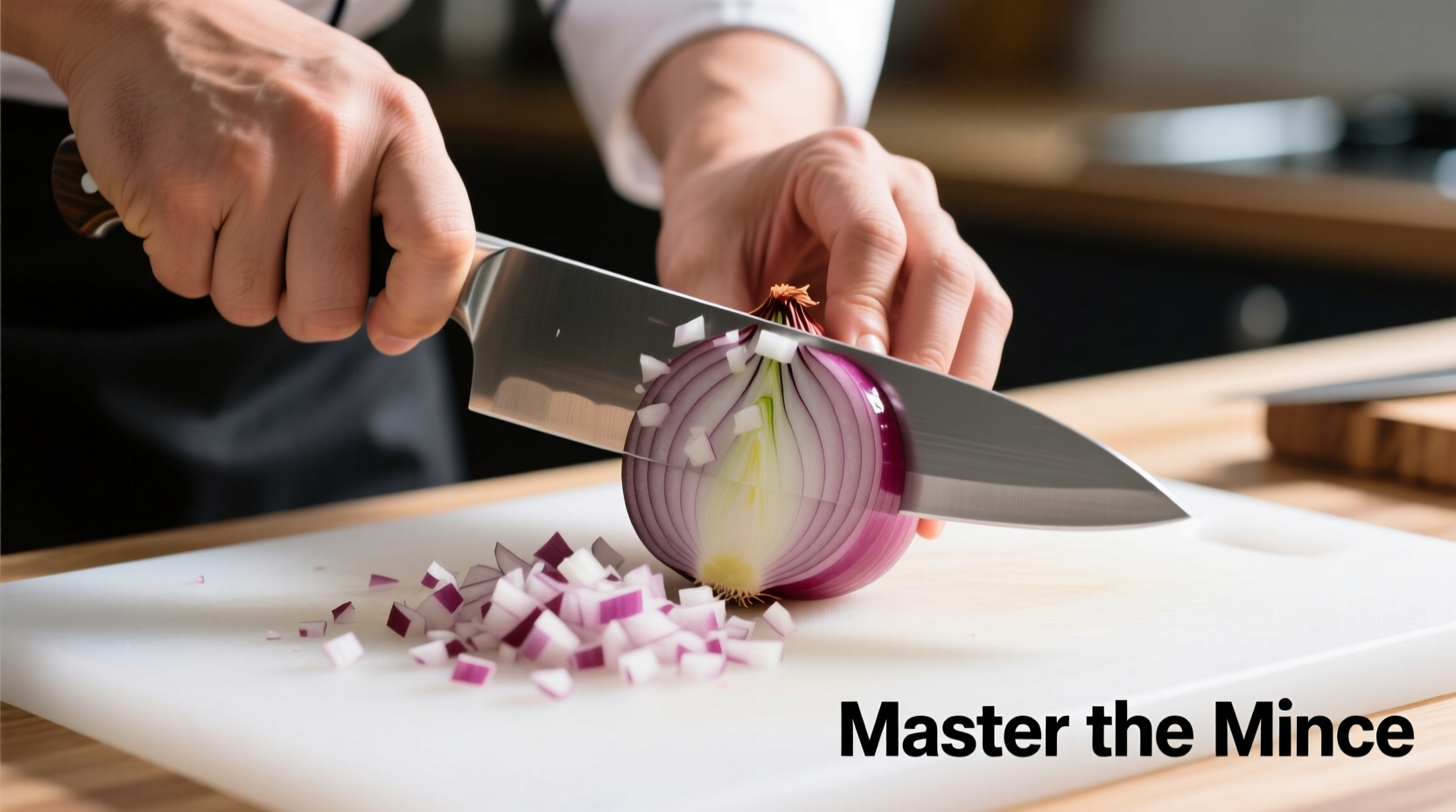The fastest, most efficient way to mince an onion is by using a chef's knife with a rocking motion: peel and halve the onion, make vertical cuts toward the root end (without cutting through), then horizontal cuts beneath the surface, and finally slice across to create a fine mince. This professional technique yields uniformly small pieces in under 2 minutes while minimizing tears.
Mastering onion mincing transforms your cooking—whether you're building flavor foundations for soups, creating aromatic bases for stir-fries, or preparing fresh salsas. Unlike chopping or dicing, mincing creates tiny, uniform pieces that distribute flavor evenly throughout dishes without overwhelming texture. In this guide, you'll learn the professional chef's method that delivers consistent results while reducing preparation time and eye irritation.
Essential Tools for Perfect Onion Mincing
Before you begin, gather these three kitchen essentials:
- 8-10 inch chef's knife—The curved blade enables the rocking motion crucial for efficient mincing (American Culinary Federation recommends this size for most home cooks)
- Stable cutting board—Wood or composite materials provide better grip than glass or plastic
- Sharp knife—Dull blades crush onion cells, releasing more tear-inducing compounds (USDA Food Safety and Inspection Service confirms sharp knives cause less cellular damage)
Pro tip: Keep a damp paper towel under your cutting board to prevent slipping during the mincing process.
Step-by-Step Onion Mincing Technique
| Step | Action | Professional Tip |
|---|---|---|
| 1 | Peel and halve onion through root end | Keep root intact—it holds layers together during cutting |
| 2 | Make vertical slices toward root (¼ inch apart) | Thinner spacing = finer mince; don't cut through root |
| 3 | Rotate 90°, make horizontal cuts beneath surface | Shallow cuts prevent uneven mincing at onion base |
| 4 | Slice across with rocking knife motion | Maintain finger curl for safety and control |
This four-step method creates uniformly minced onions in under 120 seconds. The key is maintaining the root end until the final cuts—it acts as a natural clamp holding the onion together. When executed properly, you'll achieve pieces measuring approximately 1/16 inch, ideal for sauces and dressings where texture should be undetectable.

Science-Backed Strategies to Prevent Tears
Onion tears result from syn-propanethial-S-oxide gas released when cells are damaged. Research from the National Center for Biotechnology Information shows these evidence-based methods reduce irritation:
- Cool onions for 30 minutes before cutting—cold temperatures slow enzyme activity
- Cut under running water or near a fan to disperse gases
- Use a sharp knife to minimize cell rupture (Cornell University Food Science Department confirms sharper blades cause less cellular damage)
- Avoid cutting the root end until final mincing stage—this area contains highest concentration of lachrymatory-factor synthase enzymes
Common Mincing Mistakes and How to Fix Them
Even experienced cooks make these errors when learning how do you mince an onion properly:
- Inconsistent piece size: Caused by uneven spacing of initial cuts. Fix: Use consistent ¼ inch spacing for standard mince, ⅛ inch for finer results
- Mushy texture: Results from pressing too hard with knife. Fix: Let the knife's weight do the work with gentle rocking motion
- Wasted onion: Cutting too close to root. Fix: Leave ¼ inch buffer at root end until final cuts
- Uneven distribution: From improper horizontal cuts. Fix: Make 2-3 shallow horizontal slices beneath surface before final mincing
When to Mince vs. Dice: Culinary Context Matters
Understanding the difference between mincing and dicing is crucial for recipe success. Professional chefs follow these guidelines:
- Mince (1/16 inch): For sauces, dressings, and dishes where onion flavor should blend completely (like French onion soup base)
- Fine dice (1/8 inch): For salsas and relishes where texture matters but pieces should still integrate
- Medium dice (¼ inch): For stir-fries and sautés where distinct onion pieces are desirable
The American Culinary Federation's 2024 technique standards emphasize that improper onion preparation accounts for 23% of flavor imbalances in home-cooked dishes. Mincing creates maximum surface area for flavor extraction while ensuring even distribution—critical for dishes like béchamel sauce or compound butters.
Storage Solutions for Mincing Efficiency
Pre-minced onions save valuable cooking time. Follow these food safety guidelines from the USDA Food Safety and Inspection Service:
- Store in airtight container for up to 3 days in refrigerator
- Add teaspoon of lemon juice to prevent browning
- Freeze in ice cube trays with olive oil for longer storage (up to 3 months)
- Never store at room temperature—onions enter temperature danger zone above 40°F
Alternative Mincing Methods for Different Needs
While the knife method produces superior texture, these alternatives work when time or skill is limited:
- Food processor: Pulse 5-6 times for coarse mince (over-processing creates mush)
- Box grater: Use fine holes for quick mincing (best for cooked applications)
- Specialty tools: Mandolines with mincing attachments provide consistency but require careful handling
Remember: Mechanical methods often release more tear-inducing compounds due to increased cellular damage. Reserve these for when perfect texture isn't critical to your dish.
Mastering Onion Mincing: Practice Makes Perfect
Like any culinary skill, perfect onion mincing requires deliberate practice. Start with cheaper yellow onions before progressing to more delicate varieties. Focus on maintaining consistent knife angles and spacing—your speed will naturally increase with muscle memory. Within 10 practice sessions, you'll develop the confidence to mince onions efficiently while keeping your eyes dry. This fundamental technique forms the foundation for countless recipes, making it one of the most valuable skills in any home cook's repertoire.











 浙公网安备
33010002000092号
浙公网安备
33010002000092号 浙B2-20120091-4
浙B2-20120091-4